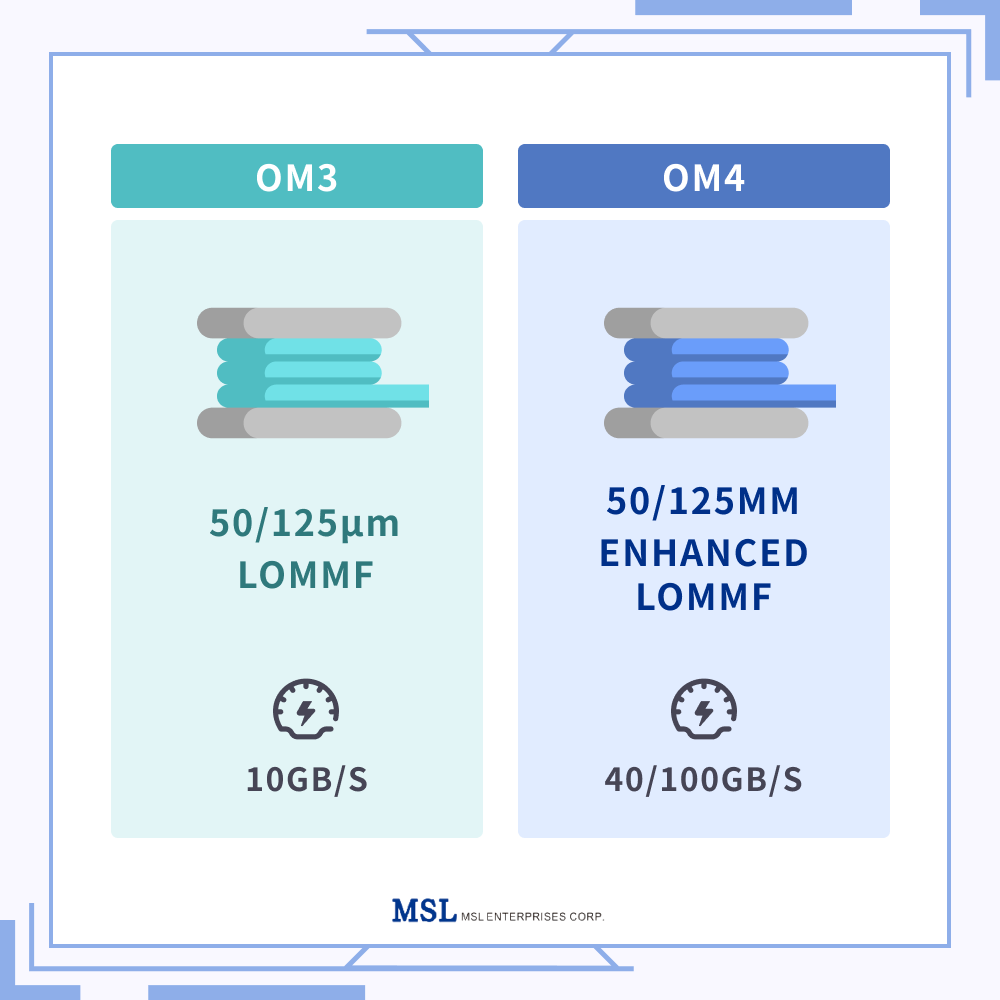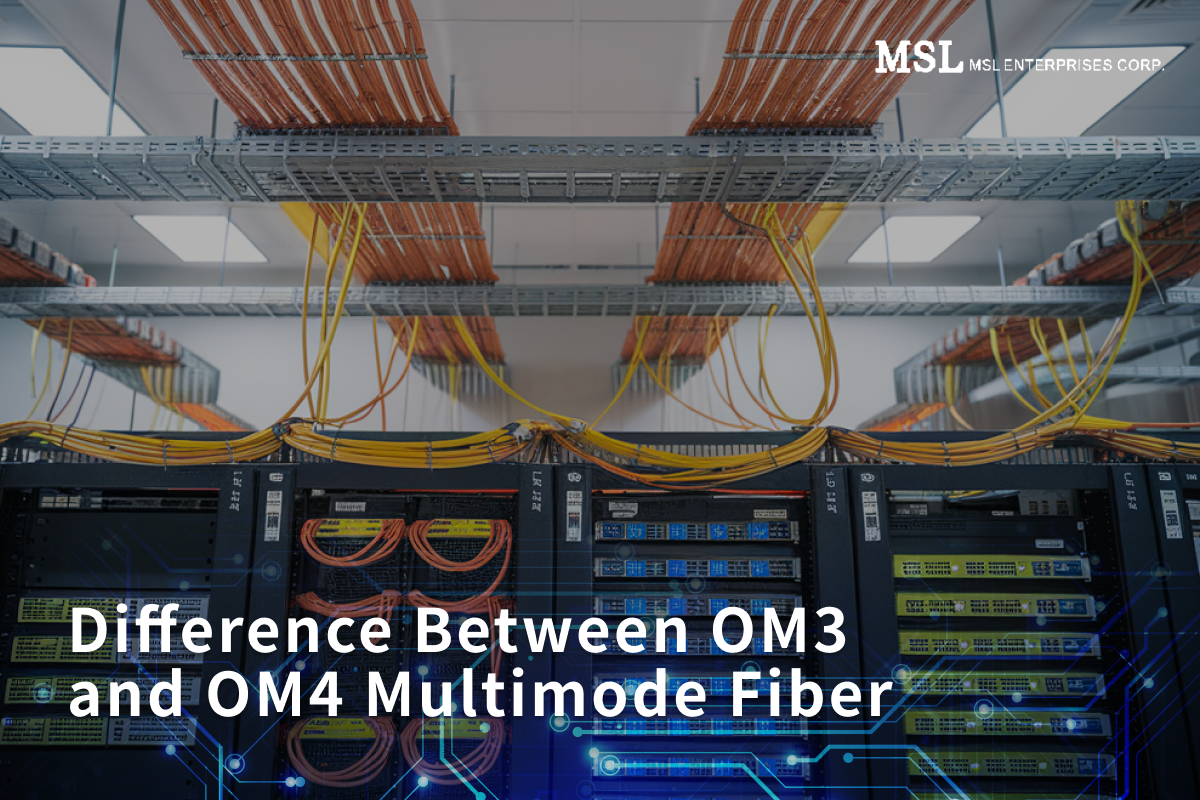| Table of Contents |
|
Difference Between OM3 and OM4 Multimode Fiber: Which to Choose |
What is OM3 and What is OM4?
OM3 and OM4 are both types of multimode fiber optic cables designed for high-speed data transmission over short to medium distances. Both fibers have a core diameter of 50 micrometers and are optimized for use with vertical-cavity surface-emitting lasers (VCSELs).
OM3 fibers are capable of supporting data rates up to 10 Gbps over distances of 300 meters, making them suitable for most standard enterprise and data center applications. The fiber's bandwidth of 2000 MHz·km provides adequate capacity for these use cases, offering a balance between performance and cost-effectiveness.
OM4, on the other hand, is an enhanced version of OM3. It features a higher bandwidth of 4700 MHz·km, which allows for greater data transmission rates and longer distances without signal degradation. OM4 fibers can support 10 Gbps transmission over distances up to 550 meters and can handle higher data rates, such as 40 Gbps and 100 Gbps, over shorter lengths (up to 150 meters). These features make OM4 ideal for environments requiring high-speed data transfer over extended distances, such as larger data centers.

Can I Use OM3 and OM4 Cables Interchangeably?
OM3 and OM4 cables can be used interchangeably as they share similar core diameters and are backward compatible. However, the overall performance will be limited to the capabilities of the lower-performing OM3 fiber, impacting data transmission speeds and maximum distance.
OM3 vs OM4: Key Differences
Both cable types are widely used in various networking environments. Below is a breakdown of the main distinctions between OM3 and OM4 cables.
Core Construction
Although both OM3 and OM4 fibers share the same core and cladding sizes, OM4 fibers are manufactured using advanced laser-optimized techniques. This results in higher performance and lower attenuation, making OM4 more effective over longer distances with less signal loss compared to OM3.
Modal Bandwidth
OM4 has a much higher modal bandwidth, offering 4700 MHz·km compared to OM3's 2000 MHz·km. This difference enables OM4 to handle significantly higher data transmission rates while maintaining strong performance over longer distances. The higher modal bandwidth allows OM4 to carry more data without experiencing degradation in quality.
Speed
OM3 is designed to support data speeds up to 10 Gbps over distances of 300 meters. OM4, on the other hand, can support the same 10 Gbps speed over 550 meters and can also handle 40 Gbps and 100 Gbps transmissions over distances up to 150 meters. This makes OM4 more suitable for demanding, high-speed applications.
Attenuation
OM4 fibers have a lower attenuation rate (around 3.0 dB/km) compared to OM3 fibers (approximately 3.5 dB/km). Lower attenuation translates to less signal loss over distance, allowing OM4 to maintain better signal quality and transmit data over longer distances than OM3.
Compatibility
Both OM3 and OM4 fibers are backward compatible with older multimode fiber systems like OM2. However, it’s important to note that in a mixed system of OM3 and OM4, the overall performance will default to the lower-performing fiber. This means an OM3-OM4 hybrid setup will operate at OM3 standards.
Distance
OM3 can transmit data at 10 Gbps over distances of up to 300 meters, whereas OM4 can achieve the same speed over 550 meters. For higher speeds (40 Gbps and 100 Gbps), OM3 supports distances up to 100 meters, while OM4 extends this range to 150 meters, making it the preferred choice for high-performance and high-speed applications.
Color
Traditionally, both OM3 and OM4 fibers are aqua-colored. However, to distinguish between the two, some manufacturers use a violet (Erika Violet) color for OM4 fibers, helping technicians quickly identify the fiber type during installation and maintenance.
Here’s a comparison table summarizing the key differences between OM3 and OM4 fibers:
| Feature | OM3 | OM4 |
| Internal Construction | Standard laser-optimized construction | Advanced laser-optimized construction for higher performance |
| Modal Bandwidth | 2000 MHz·km | 4700 MHz·km |
| Supported Speed | Up to 10 Gbps over 300 meters | Up to 10 Gbps over 550 meters; supports 40/100 Gbps over 150 meters |
| Attenuation | ~3.5 dB/km | ~3.0 dB/km |
| Transmission Distance | 10 Gbps up to 300m; 40/100 Gbps up to 100m | 10 Gbps up to 550m; 40/100 Gbps up to 150m |
| Compatibility | Backward compatible with OM2 | Backward compatible with OM3, OM2 |
| Color | Aqua | Aqua (sometimes violet to differentiate) |
| Applications | Standard enterprise setups, smaller data centers | Large data centers, high-performance environments, future-proof setups |
Which Fiber Cable to Choose: OM3 or OM4?
When it comes to selecting the right fiber optic cable for your network, the choice between OM3 and OM4 can greatly affect performance, scalability, and cost. Both cables are widely used in various networking environments, but each has distinct advantages depending on your specific needs. We’ll break down the key factors to consider, so you can make the best decision for your setup.
Performance and Transmission Distance
OM4 fiber delivers superior performance due to its lower attenuation, which minimizes signal loss and ensures higher data integrity over longer distances. This makes it ideal for environments that require speed and reliability, such as large data centers. OM4 supports up to 550 meters for 10 Gbps and 150 meters for 40/100 Gbps, whereas OM3 handles 10 Gbps over 300 meters and 40/100 Gbps over 100 meters. For larger setups, OM4 is the better choice for extended cable runs.
Application Requirements
The choice between OM3 and OM4 depends on your application. OM4 is ideal for large-scale networks like data centers, offering higher speeds and longer distances, while OM3 is a cost-effective option for smaller setups, such as office networks, with moderate bandwidth and distance needs. OM4 is best for environments requiring scalability and future-proofing.
Scalability for the Future
If you anticipate future upgrades to higher data rates or an expanded network infrastructure, OM4 is a better investment. Its higher bandwidth and superior performance ensure that it can handle future data demands, offering a future-proof solution. With OM4, you won’t need frequent replacements when upgrading your network speeds or technologies.
Budget Considerations
OM4 fiber cables cost more, typically $1 to $2 per meter, compared to OM3’s $0.25 to $1 per meter. However, OM4 offers better performance and scalability, making it a future-proof investment that reduces the need for upgrades. For budget-conscious users, OM3 is a reliable, cost-effective option for standard applications.
What about OM1, OM2, and OM5?
Apart from OM3 and OM4 fibers, there are also OM1, OM2, and OM5. The OM3 and OM4 serve as a middle ground between the older OM1 and OM2 fibers and the latest OM5 fiber. Let’s get to know more details about them.
OM1 vs. OM2
OM1 and OM2 fibers are the older generations of multimode fibers.
OM1 has a core diameter of 62.5 microns, supports up to 1 Gbps data rates over 275 meters, and up to 10 Gbps over 33 meters. It commonly features an orange jacket and uses LED as its light source. OM2 has a smaller core diameter of 50 microns but still uses LED, improving bandwidth and supporting 1 Gbps over 550 meters and 10 Gbps up to 82 meters.
Both OM1 and OM2 are generally used for short-range transmissions and in LANs, making them less suitable for modern high-speed applications compared to OM3 and OM4.
OM5
OM5 is the latest addition to the multimode fiber family, also known as Wideband Multimode Fiber (WBMMF). It maintains the same core diameter as OM3 and OM4 (50 microns) but offers enhanced capabilities for higher data rates.
OM5 is designed for use with Short Wavelength Division Multiplexing (SWDM), allowing it to support multiple wavelengths between 850 and 953 nm. This design supports a minimum of four WDM channels, with each channel capable of speeds of at least 28 Gbps.
OM5 supports distances up to 100 meters for 40 Gbps and 100 Gbps Ethernet, making it suitable for high-speed data center applications. Its lime-green jacket helps distinguish it from OM3 and OM4 fibers.
MSL - Your Trusted Multimode Fiber Cable Supplier
OM3 and OM4 are multimode fiber optic cables designed for high-speed data transmission. When choosing between OM3 and OM4, understanding their differences is key. OM3 is ideal for standard networks, while OM4, with its higher modal bandwidth and lower attenuation, is the better choice for high-performance environments like data centers.
For high-quality multimode fiber solutions, MSL Enterprises Corp. is your trusted supplier. Established in 1987, MSL specializes in manufacturing fiber cables, such as OM3 and OM4, delivering custom solutions to clients worldwide. With advanced laboratories and factories in China and Vietnam, MSL offers competitive pricing, fast lead times, and products built to ISO-9001 and ISO-14001 standards. With cutting-edge fiber assembly technology and multiple production lines, we can provide a broad spectrum of specifications, fully customized to meet your unique requirements. Whether you need reliable cables for standard office networks or high-speed data centers, MSL has the expertise and capacity to meet your needs.


